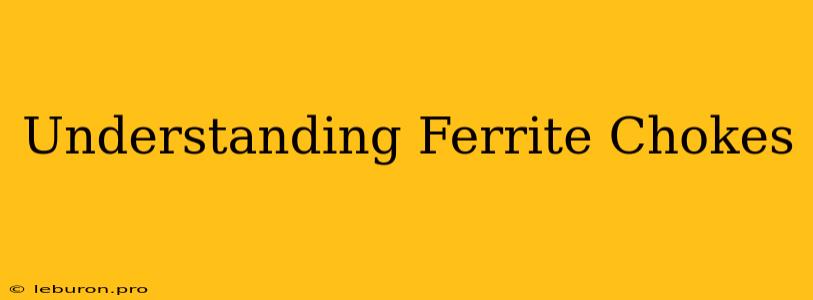Understanding Ferrite Chokes: A Comprehensive Guide
Ferrite chokes are passive electronic components that play a crucial role in filtering and suppressing unwanted electromagnetic interference (EMI) in electronic circuits. They are often used in power supplies, switching circuits, and other applications where noise reduction is essential for proper operation and electromagnetic compatibility (EMC). This article will delve into the fundamentals of ferrite chokes, exploring their construction, working principles, applications, and key considerations for choosing the right choke for your specific needs.
What is a Ferrite Choke?
A ferrite choke is an inductor made of a magnetically permeable material called ferrite. Ferrite is a ceramic-like material with high magnetic permeability, which means it can easily be magnetized and demagnetized. This property is essential for chokes, as it allows them to effectively filter high-frequency signals.
Construction of a Ferrite Choke
A typical ferrite choke consists of the following:
- Ferrite Core: The core of the choke is made of ferrite material, typically shaped like a toroid, bead, or rod. The shape and size of the core affect the choke's inductance and impedance.
- Coil: A coil of copper wire is wound around the ferrite core. The number of turns in the coil determines the choke's inductance.
- Leads: The coil is connected to leads that allow the choke to be easily integrated into a circuit.
Working Principle of a Ferrite Choke
The working principle of a ferrite choke relies on the inductor's property of opposing changes in current. When an alternating current (AC) flows through the coil, it creates a changing magnetic field in the ferrite core. This changing magnetic field induces a voltage across the coil that opposes the original current flow. This opposing voltage effectively suppresses the high-frequency components of the current, while allowing the desired low-frequency signal to pass through.
The effectiveness of a ferrite choke in filtering out EMI is determined by its inductance, which is measured in Henries (H). Higher inductance leads to a greater impedance for high-frequency signals, resulting in better noise suppression.
Types of Ferrite Chokes
Ferrite chokes come in various shapes and sizes, each designed for specific applications. Here are some common types:
- Toroidal Chokes: These chokes are shaped like a donut or ring. They offer good efficiency and high inductance, making them suitable for power supply applications.
- Bead Chokes: These chokes are small, bead-shaped components. They are commonly used for suppressing high-frequency noise in high-speed digital circuits.
- Rod Chokes: These chokes have a cylindrical shape. They are often used in radio frequency (RF) applications.
Applications of Ferrite Chokes
Ferrite chokes find widespread use in various electronic circuits and systems, including:
- Power Supplies: Chokes are used in power supplies to filter out unwanted noise and ripple from the output voltage.
- Switching Circuits: Chokes are essential in switching circuits to suppress switching noise and improve EMC.
- High-Speed Digital Circuits: Chokes help reduce EMI in high-speed digital circuits, ensuring data integrity.
- Audio Equipment: Chokes can be used in audio circuits to filter out unwanted noise and improve signal quality.
- RF Applications: Ferrite chokes play a vital role in RF circuits, helping to suppress interference and improve signal reception.
Considerations for Choosing a Ferrite Choke
Selecting the appropriate ferrite choke for your application involves considering several factors:
- Inductance: The inductance determines the choke's ability to filter out noise. Choose a choke with sufficient inductance to suppress the desired frequency range.
- Current Rating: The choke must be able to handle the current flow without overheating or degrading its performance.
- Frequency Range: Consider the frequency range of the signals you want to filter. Different choke types have different operating frequency ranges.
- Size and Shape: The size and shape of the choke should be compatible with your circuit board and overall system design.
- Temperature Rating: Ensure the choke's operating temperature range is suitable for the intended environment.
Conclusion
Ferrite chokes are essential components in electronic circuits, playing a crucial role in suppressing electromagnetic interference and improving signal integrity. Understanding the principles of ferrite chokes, their various types, applications, and key selection criteria is crucial for designing and troubleshooting circuits effectively. By utilizing the appropriate ferrite choke, designers can ensure proper circuit operation and achieve desired electromagnetic compatibility, paving the way for robust and reliable electronic systems.
